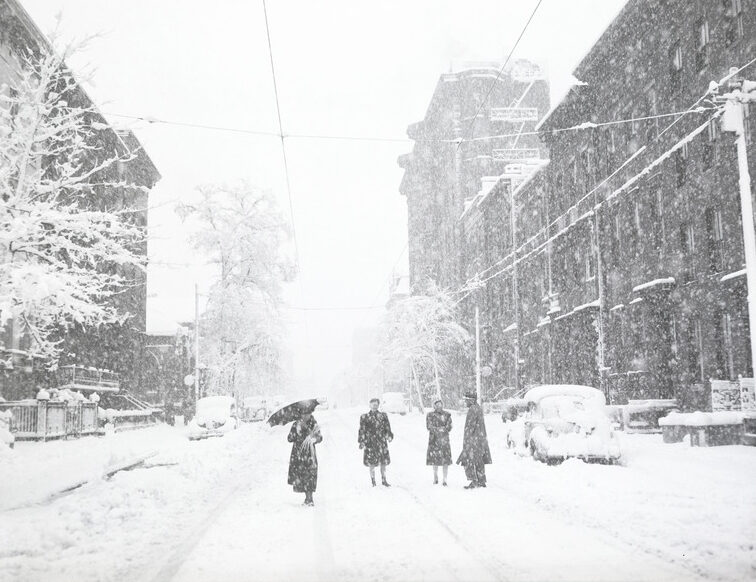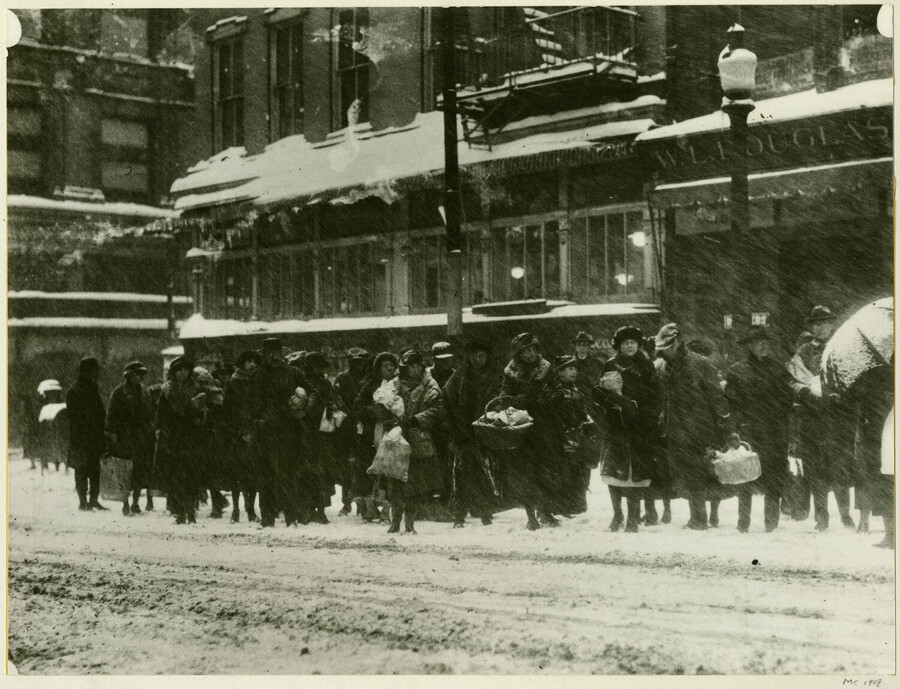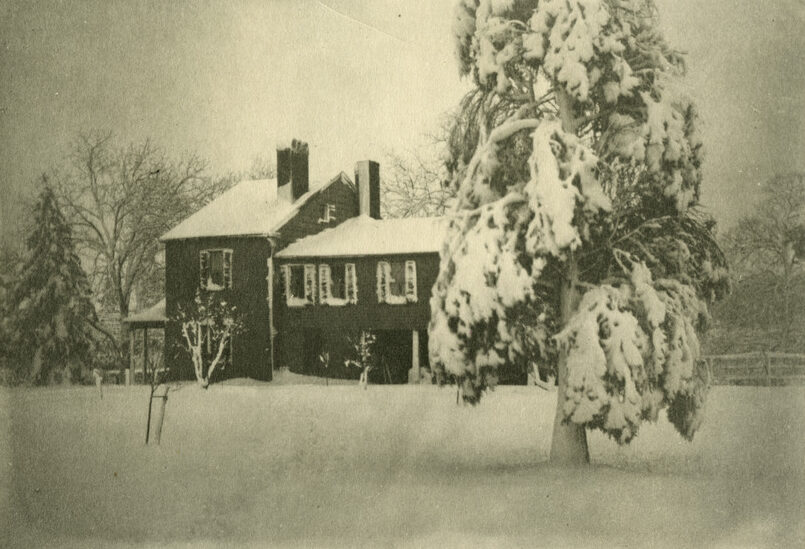Losing Winter: New Participatory Exhibition Opening in July 2021
In this blog post guest contributor Martha Oster-Beal, Community Engagement Manager at the Maryland Center for History and Culture, interviews Baltimore-based artist Lynn Cazabon about her involvement in an upcoming exhibition at MCHC.
Losing Winter is a participatory art project and archive of memories about the season of winter. At the heart of the project are recordings of participants’ memories—the wooly smell of wet mittens, a carrot for a nose, snowflakes sparkling on marble steps. These recollections of weather intersect with individual lifetimes and places found in the film and photograph collections of the H. Furlong Baldwin Library at the Maryland Center for History and Culture. Memories and images intertwine, providing a window into personal loss in the face of a changing climate.
Lynn Cazabon, a Baltimore-based artist and professor of Art at University of Maryland, Baltimore County (UMBC), is the artist behind Losing Winter. Learn about her work, which has been exhibited internationally, at lynncazabon.com.
We asked Lynn to tell us more about the concept of Losing Winter.
MCHC: How did this project start? Where does your inspiration come from?
LC: I was inspired by a photograph of myself that my father took when I was about 14 years old, sitting beside frozen Lake St. Clair in Michigan, where I grew up. The image brought up a vivid memory of how frigid I felt at that moment. All the other details of that afternoon came rushing back to me.

The photograph also made me think about how the lake doesn’t reliably freeze anymore and how winter has gradually warmed within my own lifetime. I also thought of my nephews who live near there, how they have a radically different perception of what is “normal” for winter. This moment eventually led to my conception for Losing Winter. I wanted to gather other people’s memories about winter—to preserve those memories but also to reflect on what is being lost with climate change on the small scale of individual lifetimes.
MCHC: Can you tell us more about your Losing Winter installation in Romania?
LC: I received a commission from the National Museum of Contemporary Art [Muzeul Național de Artă Contemporană, or MNAC, in Romanian] in Bucharest, Romania, to realize the initial version of Losing Winter and in summer 2018 I spent 3 months there creating it on location. To start, working with the museum, I approached a local ice cream company and asked them to sponsor the project in the form of donating individual ice creams that would be given out to participants in exchange for a memory. Next we created posters and postcards to promote a series of public events hosted with local businesses and also with a senior community. At each event, I asked people to share a memory connected to the season of winter, which was recorded–I used audio only in this version–and they received an ice cream in exchange. But since I do not speak Romanian, I had a lot of help, from bilingual assistants. We gathered about 130 memories in the end. From those, I selected 10 memories to recreate as ice sculptures to be featured in a video I conceived to make. I worked with a local ice artist who usually creates sculptures for weddings and parties. I sent him drawings and collages of my concepts for the selected memories and from those, he created beautiful sculptures in ice which were delivered to the museum one hot July morning for the filming, which we did over two days. The resulting video, Melt, shows the melting sculptures positioned in key locations in and around the museum. MNAC is situated in a politically poignant place: inside the Palace of the Parliament, the colossal Neoclassical building that was the final act of urban planning by dictator Nicolae Ceaușescu in the 1980s, and across from the newly constructed and controversial People’s Salvation Cathedral. The Cathedral is featured in the video behind an ice sculpture of the Romanian flag with the communist insignia cut out. The flag was part of one participant’s memory–the fall of communism in Romania took place in winter 1989. The final exhibition of the project at MNAC included Melt as well as headphones on which visitors could listen to the recorded memories. There was also a project website that contained all the memories with bilingual translations.

Image: Snow on Palm Sunday on Park Avenue, photograph by A. Aubrey Bodine, March 29, 1942, B1548.2. A. Aubrey Bodine Photograph Collection, Baltimore City Life Museum Collection, H. Furlong Baldwin Library, Maryland Center for History and Culture.
MCHC: How do you think images in the MCHC collection will complement the collected memories of winter?
LC: For this version of Losing Winter, I want to focus on the state of Maryland, asking for memories from people from Maryland or who have lived here a long time. I feel it makes perfect sense as a complement to these memories to display archival photographs and films from the MCHC collection, representing places across the state of Maryland during the season of winter over time. I’m excited to see what we can find. For the curation of the historical portion of the MCHC exhibition, I’ll be working alongside MCHC curator Joe Tropea.

Image: Blizzard of 1922 at Howard and Lexington Streets, unidentified photographer, January 28, 1922, MC1909. Municipal Museum Collection, Baltimore City Life Museum Collection, H. Furlong Baldwin Library, Maryland Center for History and Culture.
MCHC: How can people share their memories of winter with you?
LC: We will be hosting public sharing workshops, which will be virtual due to the pandemic, during which I will tell people about the project and ask them to share a memory which will be recorded on video. Also, people can share memories by recording themselves conveying the memory on video using their own mobile device. Last spring, I received a Saul Zaentz Innovation Fund Grant to create a mobile app for the project, which is scheduled to be ready in early 2021. I’m collaborating with artist Lee Boot and the Imaging Research Center at UMBC on the creation of the app. The app will allow people to record and upload a memory which will later become integrated into the display portion of the app. The memories will be experienced through an augmented reality interface showing a shower of raindrops overlaid onto the scene in which the person is standing. Embedded inside each droplet will be an image of a participant. Tapping on the screen will temporarily “freeze” droplets and initiate the corresponding video and audio to play. After the video plays, the frozen droplets will melt, turning back into water.

Image: Fires and Explosions – Stores and Business Establishments – Anderson and Ireland Hardware, unidentified photographer, February 1904. Subject Vertical File, H. Furlong Baldwin Library, Maryland Center for History and Culture.
MCHC: What do you hope people will take away from the exhibition?
LC: Sadly, climate change is still abstract to many people and one of the goals of Losing Winter is to make climate change tangible by asking people to reflect on how they remember how things were when they were younger. I also hope the project draws attention to the intricate connection between every aspect of our lives and the climate in which we live. The project is not so much focused on the causes of climate change as it is on the lived experience of it. In fact, I conceived of the project in a way that circumvents the topic of climate change altogether. I deliberately use the clichéd conversation starter of the weather as a means to approach and include anyone in the project, even those who might disagree with me about the reality or causes of climate change. I want the project to focus attention on what is being lost at a very local level but also to initiate conversation. I also want to preserve these memories of winter for younger generations so they can understand what has been lost and to in turn inspire action.

Image: Nancy’s Fancy in Winter, photograph by Emily Spencer Hayden, undated, PP92.077. Emily Spencer Hayden Photograph Collection, PP92, H. Furlong Baldwin Library, Maryland Center for History and Culture.
Visit our Program Calendar for information about upcoming workshops and how you can contribute your memories.
Martha Oster-Beal loves learning about local histories and making connections to the present day. She proudly resides in the Hoes Heights neighborhood of Baltimore City and spends her free time tending her perennial garden, reading mysteries, and endlessly loving her dog, Tia.

